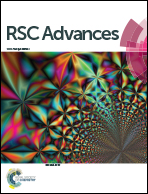Highly efficient selective hydrogenation of levulinic acid to γ-valerolactone over Cu–Re/TiO2 bimetallic catalysts†
Abstract
Highly active and thermally stable Cu–Re bimetallic catalysts supported on TiO2 with 2.0 wt% loading of Cu were prepared via an incipient wetness impregnation method and were applied for liquid phase selective hydrogenation of levulinic acid (LA) to γ-valerolactone (GVL) in H2. The effect of the molar ratios of Cu : Re on the physico-chemical properties and the catalytic performance of the Cu–Re/TiO2 catalysts was investigated. Moreover, the influence of various reaction parameters on the hydrogenation of LA to GVL was studied. The results showed that the Cu–Re/TiO2 catalyst with a 1 : 1 molar ratio of Cu to Re (Cu–Re(1 : 1)/TiO2) exhibited the highest performance for the reaction. Complete conversion of LA with a 100% yield of GVL was achieved in 1,4-dioxane solvent under the reaction conditions of 180 °C, 4.0 MPa H2 for 4 h, and the catalyst could be reused at least 6 times with only a slight loss of activity. Combined with the characterization results, the high performance of the catalyst was mainly attributed to the well-dispersed Cu–Re nanoparticles with a very fine average size (ca. 0.69 nm) and the co-presence of Cu–Re bimetal and ReOx on the catalyst surface.



 Please wait while we load your content...
Please wait while we load your content...